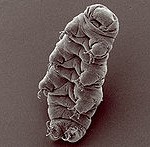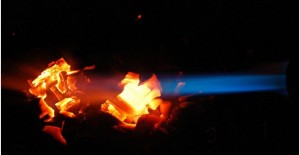Tardigrades are water-dwelling micro-animals. They love mosses and lichens when they have a choice of habitat and measure in at approximately 1.5 millimeters long. Called “water bears” because of their appearance under a scanning electron microscope, these little guys actually resemble a cross between a gummy bear you found under your sofa and some fat creature from Star Wars.

Tardigrades aren’t a new species to the planet (fossils of Tardigrades have been found dating back to over 500 million years ago), nor have they just been recently discovered (they were first discovered by a German scientist in 1773). Their recent boom in popularity is a product of their incredible attributes and the power of social media. Many tardigrade enthusiasts stumbled upon an article about or a picture of these incredible creatures and got hooked after reading about them.
With such a glowing introduction, you are probably asking yourself, “Okay, so what is it that makes these tiny eight-legged water gummy bears so special?” The answer: they are pretty much invincible when it comes to environmental stresses. If you’re that jerk that is thinking “They aren’t invincible, they could be eaten,” then pat yourself on the back, but no one else cares that you felt the need to make this obvious point. Tardigrades are remarkable because they have the ability to survive the harshest of climates and atmospheric conditions by resorting to a state of deeply suspended animation. With a metabolic rate dropping to 0.01% of its norm, this state (called a “tun”) closely resembles death.
How do they do this? By retracting their heads and legs and essentially dehydrating themselves, they can withstand incredibly environmental stress. Think about it. The damage caused by extreme low and high temperatures has to do with the water in our cells. Without the water, these tuns are virtually indestructible. They have been tested and studied extensively, and have proven able to survive being heated to 150 degrees Celcius, frozen to almost absolute zero, exposed to extreme amounts of radiation, and even sent into space.

By simply adding water back to these tuns, even after almost a decade, they will reanimate and continue on with their lives. Talk about a power nap. Tardigrades are fascinating creatures because of their insane ability to cope with life, but also because of the mystery behind their powers. Many processes that other organisms use to survive extreme heat or cold do not occur in tardigrades. They seem to have their own unique ways of protecting or repairing their DNA after exposure to harmful environments. Expect to hear a lot about these water bears in the future, as they will surely be a hot topic among researchers. After all, they have an Octonauts episode about them. You know you’ve made it as an actor when you get invited to be on Sesame Street, and you know you’ve made it as a marine organism when you are the subject of an Octonauts episode.